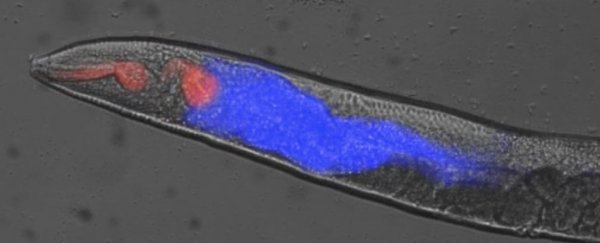When it comes, it's unstoppable. An inescapable wave of cellular death no Earthly organism can deny - but it doesn't happen the same way for everybody.
For the first time, scientists have observed the phenomenon of rigor mortis – the 'stiffness of death' – seizing hold of dying worms. But while human bodies plank for the last time in death's final stages, worms seem to have it around backwards.
"What really surprised us at first was that rigor mortis in worms begins while they are still alive," explains molecular biologist Evgeniy Galimov from University College London.
In humans, death occurs when our heart stops beating and our brain ceases to function – but our physiological processes don't have exact equivalents in the tiny bodies of the roundworm Caenorhabditis elegans, which is why the grim reaper has to go about things a little bit differently here.
"We realised that death from circulatory failure, as in mammals, doesn't happen in C. elegans," says Galimov.
"The worms are so small they don't need a circulatory system to get oxygen for respiration."
 (David Gems/UCL)
(David Gems/UCL)
In 2013, members of the same research team uncovered what death looks like in this transparent nematode, capturing a remarkable "burst of intense blue fluorescence" that ripples through their bodies as their cells die.
This time around, the researchers dug deeper, discovering that the blue wave of necrosis is coupled with a rigor-mortis-like stiffening, as the roundworm's muscles restrict in a final death contraction – even as the rest of the body continues to wiggle like nothing special is going on.
The problem here is calcium. As death spreads through the body, dying cells trigger the death of those adjacent to them by releasing the chemical, and by the time this unstoppable wave hits the intestine, the blue fluorescence is generated by a burst of anthranilic acid.
"It's like a blue grim reaper, tracking death as it spreads throughout the organism until all life is extinguished," explained one of the team, David Gems, back in 2013.
 (David Gems/UCL)
(David Gems/UCL)
Of course, you might be wondering what exactly roundworm death has to do with human mortality.
That's an excellent question, and it's something the team wants to know too. While there are obviously lots of differences between human bodies and nematodes, there are also similarities, and if we can glean enough about what they are, it could help us understand ways of preventing death taking hold.
At the centre of the puzzle is ATP (adenosine triphosphate), the molecular unit of energy transfer found in all living things.
Cells release their deadly calcium when their ATP depletes – but it remains unclear exactly how, why, and when ATP levels drop, and at what point death in an organism becomes inevitable.
In this study, ATP levels didn't diminish significantly until the nematodes were very close to death, which could help us understand more about senescence – how our bodies deteriorate with age.
"Discovering rigor mortis in worms is exciting as it highlights a key step in the chain of events leading from healthy adulthood to death from old age," says Gem.
"It helps us to understand death in humans, and perhaps in the future to prevent death in mortally ill patients."
Before we get there though, there's a lot more research to be done. What else can C. elegans tell us about the processes of organism death? Can they be modified, perhaps even resisted?
Right now, we don't have the answers, and as the researchers acknowledge, the forces we're up against are beyond formidable.
"The way death spreads from cell to cell by calcium is like a house burning down," Galimov says.
We just have to figure out how to put the fire out.
The findings are reported in Cell Reports.
